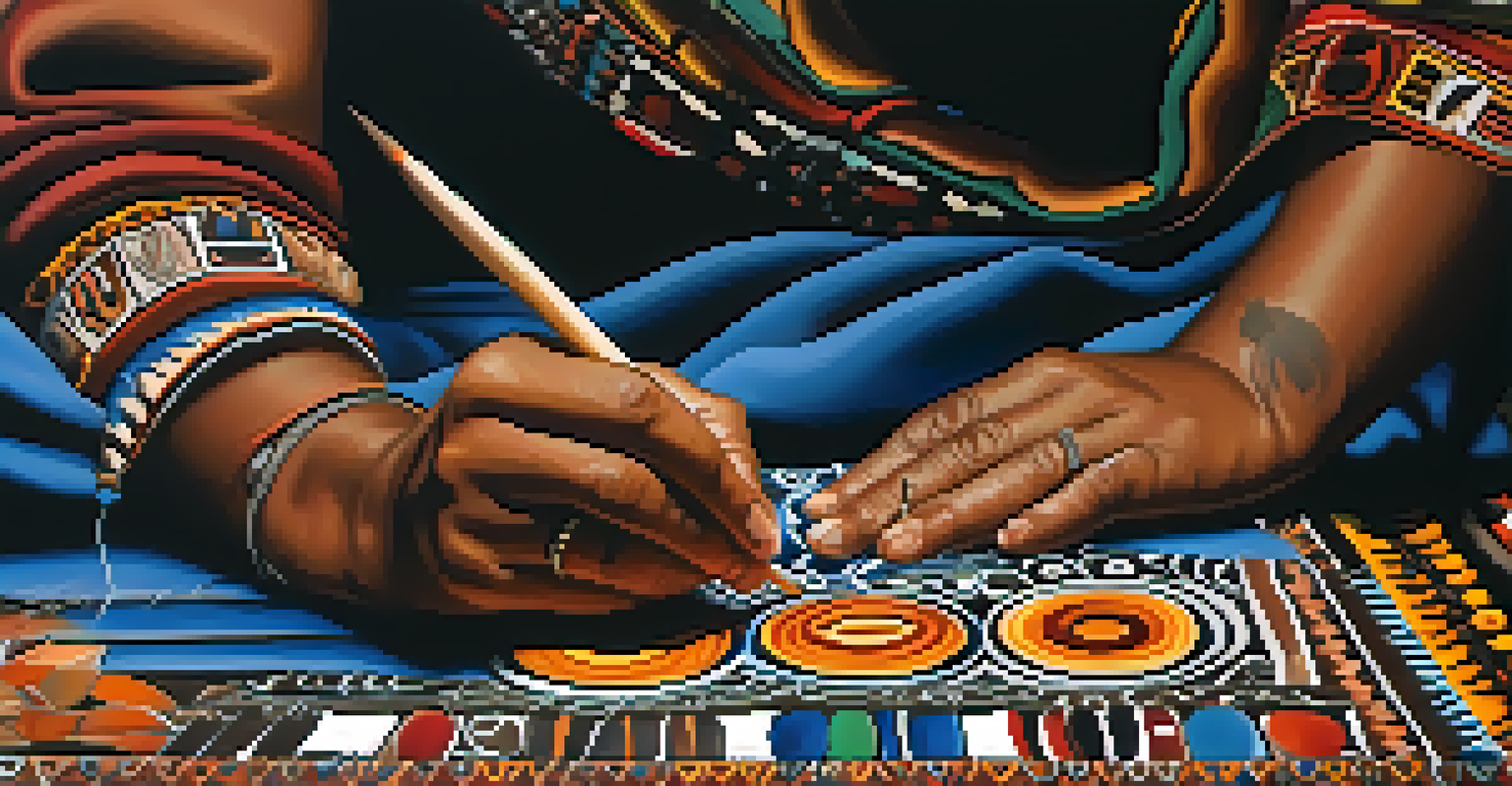Exploring the Symbolism in Aboriginal Australian Paintings

Understanding Aboriginal Art: A Cultural Perspective
Aboriginal art is not merely decorative; it's a profound expression of cultural identity. Each piece reflects the stories, beliefs, and traditions of Aboriginal peoples, often tied closely to the land and its history. This art form serves as a visual language, communicating narratives that have been passed down through generations.
Art is a powerful tool for cultural preservation and can be a bridge between generations.
These artworks often incorporate symbols that represent various elements of life, from the Dreamtime stories to local flora and fauna. For instance, a circle might symbolize a waterhole, while concentric circles can represent a meeting place. Understanding these symbols can significantly enhance our appreciation of the art.
In many ways, Aboriginal paintings act as a bridge between the past and the present, preserving ancestral knowledge while also adapting to contemporary expressions. This melding of ancient and modern illustrates the living culture of Aboriginal people and their ongoing connection to their heritage.
The Role of Dreamtime in Aboriginal Symbolism
Dreamtime, or 'Tjukurpa,' is a fundamental aspect of Aboriginal culture and spirituality. It encompasses the creation stories that explain the origins of the land, people, and animals. When you look at an Aboriginal painting, you're often witnessing a visual representation of these sacred stories.

For example, a painting depicting the footprints of a kangaroo may refer to a specific journey from Dreamtime, illustrating the connection between the spiritual and physical worlds. These narratives not only convey the significance of nature but also emphasize the responsibilities of Aboriginal people to protect and maintain their environment.
Aboriginal Art as Cultural Identity
Aboriginal art is a profound expression of cultural identity, reflecting stories, beliefs, and traditions tied to the land.
By embedding these stories in their art, Aboriginal artists ensure that the teachings of Dreamtime remain alive and relevant. This continuity is crucial for cultural identity, making each painting a vital link to the past and a guide for future generations.
Common Symbols and Their Meanings in Aboriginal Art
Aboriginal artworks are rich with symbols, each carrying its own significance. For instance, the 'U' shape often symbolizes a person or a group of people, while lines can represent tracks or pathways taken in the landscape. Recognizing these symbols allows viewers to decode the messages embedded within the artwork.
Aboriginal art is a visual language that carries the stories and wisdom of the land and its people.
Water is another prominent symbol in Aboriginal art, representing life and sustenance. Depictions of rivers, lakes, or rain can signify not just the physical aspects of water, but also the spiritual connections to life-giving forces. These symbols create a narrative that is both personal and universal.
As you delve deeper into the meanings behind these symbols, you may find that they resonate with your own experiences. This shared understanding can foster a greater appreciation for Aboriginal art, highlighting its role as a form of storytelling that transcends cultural boundaries.
Art as a Tool for Cultural Preservation
For Aboriginal artists, creating art is more than just a form of expression; it’s a way to preserve culture and share knowledge. Many contemporary Aboriginal artists are committed to using their work to educate others about their history, customs, and beliefs. This is particularly important given the challenges faced by Aboriginal communities.
Through exhibitions and community projects, these artists invite audiences to engage with their culture in meaningful ways. This not only raises awareness but also fosters respect for Aboriginal traditions and perspectives. The act of painting becomes a vehicle for cultural dialogue and understanding.
Dreamtime Shapes Aboriginal Symbolism
The Dreamtime narratives are visually represented in Aboriginal art, connecting spiritual and physical worlds through sacred stories.
Moreover, as the global art scene becomes increasingly interconnected, Aboriginal art gains visibility and recognition. This platform allows artists to advocate for their communities, ensuring that their voices and stories are heard and valued in a broader context.
The Influence of Nature in Aboriginal Paintings
Nature plays a pivotal role in Aboriginal art, providing inspiration as well as a source of sustenance. The landscapes of Australia—its deserts, forests, and coastlines—are not just backdrops but integral components of the stories told through art. This connection to nature is often portrayed with vibrant colors and intricate patterns.
Many Aboriginal artists draw upon their intimate knowledge of the land and its ecosystems to create stunning visual representations. For example, the depiction of a bushfire may symbolize renewal and the cyclical nature of life, reflecting the artist's deep understanding of environmental processes.
In this way, Aboriginal art serves as a reminder of the relationship between people and their environment. It encourages viewers to consider their own connections to nature and the importance of respecting and preserving these vital ecosystems.
Contemporary Trends in Aboriginal Art
While traditional Aboriginal art is steeped in history, contemporary artists are reinterpreting these age-old practices, bringing fresh perspectives and techniques. Many are experimenting with mixed media, digital art, and street art, blending traditional symbols with modern themes. This evolution keeps the art form relevant and engaging for new audiences.
Some artists are also addressing contemporary social issues, using their work as a platform to raise awareness about challenges faced by Aboriginal communities today. This fusion of the old and new not only honors their heritage but also challenges viewers to think critically about current narratives.
Contemporary Trends in Aboriginal Art
Contemporary Aboriginal artists are blending traditional practices with modern techniques to address social issues and engage new audiences.
By embracing innovation while respecting tradition, contemporary Aboriginal artists are expanding the boundaries of their art form. This dynamic approach ensures that Aboriginal art continues to thrive, fostering ongoing conversations about identity, culture, and resilience.
The Global Impact of Aboriginal Art
Aboriginal art has gained recognition beyond Australia, captivating audiences worldwide with its unique styles and profound meanings. This global interest has opened doors for Aboriginal artists, allowing them to share their stories and perspectives on a larger stage. Exhibitions and collaborations have emerged, creating opportunities for cross-cultural exchanges.
As Aboriginal art enters the international art market, it challenges stereotypes and misconceptions about Indigenous cultures. Viewers are invited to appreciate the depth and diversity of Aboriginal stories, moving beyond surface-level interpretations. This shift is essential for fostering a more nuanced understanding of Indigenous peoples.

Moreover, the global visibility of Aboriginal art contributes to the preservation of culture, as more people become aware of its significance. As interest grows, so does the desire to support Aboriginal artists and their communities, promoting sustainability and cultural pride.